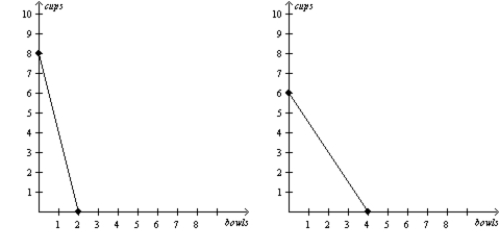A) 0.625 pound of meat.
B) 1.0 pounds of meat.
C) 1.6 pounds of meat.
D) 3.2 pounds of meat.
F) B) and C)
Correct Answer

verified
Correct Answer
verified
Multiple Choice
Absolute advantage is found by comparing different producers'
A) opportunity costs.
B) payments to land, labor, and capital.
C) input requirements per unit of output.
D) locational and logistical circumstances.
F) All of the above
Correct Answer

verified
Correct Answer
verified
Multiple Choice
Table 3-18
The following table contains some production possibilities for an economy for a given month.
 -Refer to Table 3-18. If the production possibilities frontier is a straight line, then "?" must be
-Refer to Table 3-18. If the production possibilities frontier is a straight line, then "?" must be
A) 150.
B) 225.
C) 300.
D) 375.
F) B) and C)
Correct Answer

verified
Correct Answer
verified
Multiple Choice
Table 3-22
Assume that Zimbabwe and Portugal can switch between producing toothbrushes and producing hairbrushes at a constant rate.
 -Refer to Table 3-22. Assume that Zimbabwe and Portugal each has 60 machine minutes available. Originally, each country divided its time equally between the production of toothbrushes and hairbrushes. Now, each country spends all its time producing the good in which it has a comparative advantage. As a result, the total output increased by
-Refer to Table 3-22. Assume that Zimbabwe and Portugal each has 60 machine minutes available. Originally, each country divided its time equally between the production of toothbrushes and hairbrushes. Now, each country spends all its time producing the good in which it has a comparative advantage. As a result, the total output increased by
A) 4 toothbrushes and 2 hairbrushes.
B) 10 toothbrushes and 5 hairbrushes.
C) 16 toothbrushes and 8 hairbrushes.
D) 20 toothbrushes and 10 hairbrushes.
F) B) and D)
Correct Answer

verified
Correct Answer
verified
Multiple Choice
Table 3-1
Assume that John and Jane can switch between producing bread and wine at a constant rate.
 -Refer to Table 3-1. Assume that John and Jane each work 24 hours. What happens to total production if instead of each person spending 12 hours producing each good, Jane spends 21 hours producing wine and 3 hours producing bread and John spends 3 hours producing wine and 21 hours producing bread?
-Refer to Table 3-1. Assume that John and Jane each work 24 hours. What happens to total production if instead of each person spending 12 hours producing each good, Jane spends 21 hours producing wine and 3 hours producing bread and John spends 3 hours producing wine and 21 hours producing bread?
A) The total production of bread and wine each rise.
B) The total production of bread rises and the total production of wine falls.
C) The total production of bread falls and the total production of wine rises.
D) The total production of bread and wine each fall.
F) B) and C)
Correct Answer

verified
Correct Answer
verified
Multiple Choice
Table 3-21
Assume that Jamaica and Norway can switch between producing coolers and producing radios at a constant rate. The following table shows the number of coolers or number of radios each country can produce in one day.
 -Refer to Table 3-21. Jamaica and Norway would not be able to gain from trade if Norway's opportunity cost of one radio changed to
-Refer to Table 3-21. Jamaica and Norway would not be able to gain from trade if Norway's opportunity cost of one radio changed to
A) 0 coolers.
B) 1 cooler.
C) 2 coolers.
D) Jamaica and Norway can always gain from trade regardless of their opportunity costs.
F) All of the above
Correct Answer

verified
Correct Answer
verified
Multiple Choice
Table 3-20
Assume that Brad and Theresa can switch between producing wheat and producing beef at a constant rate.
 -Refer to Table 3-20. Brad has an absolute advantage in the production of
-Refer to Table 3-20. Brad has an absolute advantage in the production of
A) wheat and Theresa has an absolute advantage in the production of beef.
B) beef and Theresa has an absolute advantage in the production of wheat.
C) both goods and Theresa has an absolute advantage in the production of neither good.
D) neither good and Theresa has an absolute advantage in the production of both goods.
F) A) and C)
Correct Answer

verified
Correct Answer
verified
Multiple Choice
Figure 3-19
Chile's Production Possibilities Frontier Colombia's Production Possibilities Frontier  -Refer to Figure 3-19. Chile would incur an opportunity cost of 36 pounds of coffee if it increased its production of soybeans by
-Refer to Figure 3-19. Chile would incur an opportunity cost of 36 pounds of coffee if it increased its production of soybeans by
A) 12 pounds.
B) 27 pounds.
C) 30 pounds.
D) 48 pounds.
F) None of the above
Correct Answer

verified
Correct Answer
verified
True/False
To produce 100 bushels of wheat, Farmer A requires fewer inputs than does Farmer B. We can conclude that Farmer A has an absolute advantage over Farmer B in producing wheat.
B) False
Correct Answer

verified
Correct Answer
verified
Multiple Choice
Table 3-31
 -Refer to Table 3-31. For the rancher, the opportunity cost of 1 pound of meat is
-Refer to Table 3-31. For the rancher, the opportunity cost of 1 pound of meat is
A) 0.4 pound of potatoes.
B) 2.5 pounds of potatoes.
C) 4 pounds of potatoes.
D) 10 pounds of potatoes.
F) A) and C)
Correct Answer

verified
Correct Answer
verified
True/False
The gains from specialization and trade are based on absolute advantage.
B) False
Correct Answer

verified
Correct Answer
verified
Multiple Choice
Table 3-21
Assume that Jamaica and Norway can switch between producing coolers and producing radios at a constant rate. The following table shows the number of coolers or number of radios each country can produce in one day.
 -Refer to Table 3-21. Assume that Jamaica and Norway each has 4 days available for production. Originally, each country divided its time equally between the production of coolers and radios. Now, each country spends all its time producing the good in which it has a comparative advantage. As a result, the total output of coolers increased by
-Refer to Table 3-21. Assume that Jamaica and Norway each has 4 days available for production. Originally, each country divided its time equally between the production of coolers and radios. Now, each country spends all its time producing the good in which it has a comparative advantage. As a result, the total output of coolers increased by
A) 12.
B) 24.
C) 36.
D) 48.
F) B) and D)
Correct Answer

verified
Correct Answer
verified
Multiple Choice
Table 3-27
Assume that Huang and Min can switch between producing parasols and producing porcelain plates at a constant rate.
 -Refer to Table 3-27. The opportunity cost of 1 parasol for Huang is
-Refer to Table 3-27. The opportunity cost of 1 parasol for Huang is
A) 1/3 plate.
B) 1/2 plate.
C) 3 plates.
D) 6 plates.
F) B) and C)
Correct Answer

verified
Correct Answer
verified
Multiple Choice
Suppose the United States has a comparative advantage over Mexico in producing pork. The principle of comparative advantage asserts that
A) the United States should produce more pork than what it requires and export some of it to Mexico.
B) the United States should produce a moderate quantity of pork and import the remainder of what it requires from Mexico.
C) the United States should refrain altogether from producing pork and import all of what it requires from Mexico.
D) Mexico has nothing to gain from importing United States pork.
F) A) and C)
Correct Answer

verified
Correct Answer
verified
Multiple Choice
Figure 3-22
Alice and Betty's Production Possibilities in one 8hour day.
Alice's Production Possibilities Frontier Betty's Production Possibilities Frontier
 -Refer to Figure 3-22. Which of the following prices would result in an mutually advantageous trade for Alice and Betty?
-Refer to Figure 3-22. Which of the following prices would result in an mutually advantageous trade for Alice and Betty?
A) 100 pizzas for 100 pitchers of lemonade
B) 100 pizzas for 125 pitchers of lemonade
C) 100 pizzas for 180 pitchers of lemonade
D) 100 pizzas for 220 pitchers of lemonade
F) None of the above
Correct Answer

verified
Correct Answer
verified
Multiple Choice
Table 3-5
Assume that Aruba and Iceland can switch between producing coolers and producing radios at a constant rate.
 -Refer to Table 3-5. Which of the following represents Iceland's production possibilities frontier when 100 labor hours are available?
-Refer to Table 3-5. Which of the following represents Iceland's production possibilities frontier when 100 labor hours are available?
A) ![]()
B) ![]()
C) ![]()
D) ![]()
F) B) and C)
Correct Answer

verified
Correct Answer
verified
Multiple Choice
Suppose that a worker in Freedonia can produce either 6 units of corn or 2 units of wheat per year, and a worker in Sylvania can produce either 2 units of corn or 6 units of wheat per year. Each nation has 10 workers. Without trade, Freedonia produces and consumes 30 units of corn and 10 units of wheat per year. Sylvania produces and consumes 10 units of corn and 30 units of wheat. Suppose that trade is then initiated between the two countries, and Freedonia sends 30 units of corn to Sylvania in exchange for 30 units of wheat. Freedonia will now be able to consume a maximum of
A) 30 units of corn and 30 units of wheat.
B) 40 units of corn and 30 units of wheat.
C) 40 units of corn and 20 units of wheat.
D) 10 units of corn and 40 units of wheat.
F) B) and C)
Correct Answer

verified
Correct Answer
verified
Multiple Choice
Figure 3-19
Chile's Production Possibilities Frontier Colombia's Production Possibilities Frontier  -Refer to Figure 3-19. If Chile and Colombia switch from each country dividing its time equally between the production of coffee and soybeans to each country spending all of its time producing the good in which it has a comparative advantage, then total production of soybeans will increase by
-Refer to Figure 3-19. If Chile and Colombia switch from each country dividing its time equally between the production of coffee and soybeans to each country spending all of its time producing the good in which it has a comparative advantage, then total production of soybeans will increase by
A) 3 pounds.
B) 6 pounds.
C) 9 pounds.
D) 12 pounds.
F) A) and C)
Correct Answer

verified
Correct Answer
verified
Multiple Choice
Figure 3-18
Bintu's Production Possibilities Frontier Juba's Production Possibilities Frontier  -Refer to Figure 3-18. Suppose Juba is willing to trade one bowl to Bintu for every two cups that Bintu makes and sends to Juba. Which of the following combinations of bowls and cups could Bintu then consume, assuming Bintu specializes in making cups and Juba specializes in making bowls?
-Refer to Figure 3-18. Suppose Juba is willing to trade one bowl to Bintu for every two cups that Bintu makes and sends to Juba. Which of the following combinations of bowls and cups could Bintu then consume, assuming Bintu specializes in making cups and Juba specializes in making bowls?
A) 1 bowl and 7 cups
B) 2 bowls and 4 cups
C) 3 bowls and 3 cups
D) 4 bowls and 1 cup
F) B) and D)
Correct Answer

verified
Correct Answer
verified
Multiple Choice
Table 3-36
 -Refer to Table 3-36. What is Barbuda's opportunity cost of one towel?
-Refer to Table 3-36. What is Barbuda's opportunity cost of one towel?
A) 3/5 umbrellas
B) 2/3 umbrellas
C) 3/2 umbrellas
D) 5/3 umbrellas
F) All of the above
Correct Answer

verified
Correct Answer
verified
Showing 221 - 240 of 527
Related Exams